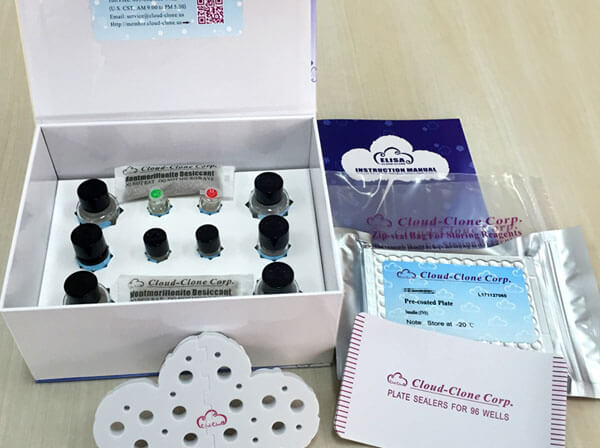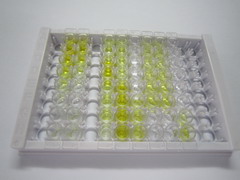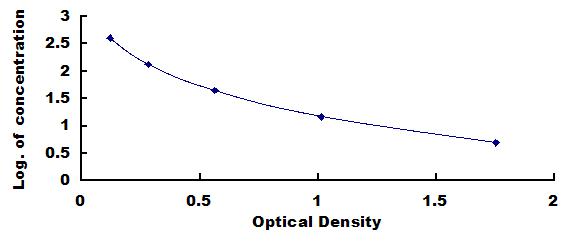ELISA Kit for Gamma-Aminobutyric Acid (gABA) 

4-Aminobutyric Acid
- UOM
- FOB US$ 471.00 US$ 673.00 US$ 3,029.00 US$ 5,722.00 US$ 47,124.00
- Quantity
Overview
Properties
- Product No.CEA900Ge
- Organism SpeciesPan-species (General) Same name, Different species.
- ApplicationsEnzyme-linked immunosorbent assay for Antigen Detection.
Research use only - DownloadInstruction Manual
- CategorySignal transductionCardiovascular biologyNeuro scienceBone metabolism
Sign into your account
Share a new citation as an author
Upload your experimental result
Review

Contact us
Please fill in the blank.
Recovery
Matrices listed below were spiked with certain level of Gamma-Aminobutyric Acid (gABA) and the recovery rates were calculated by comparing the measured value to the expected amount of Gamma-Aminobutyric Acid (gABA) in samples.
| Matrix | Recovery range (%) | Average(%) |
| serum(n=5) | 91-99 | 95 |
| EDTA plasma(n=5) | 79-101 | 96 |
| heparin plasma(n=5) | 99-105 | 102 |
Precision
Intra-assay Precision (Precision within an assay): 3 samples with low, middle and high level Gamma-Aminobutyric Acid (gABA) were tested 20 times on one plate, respectively.
Inter-assay Precision (Precision between assays): 3 samples with low, middle and high level Gamma-Aminobutyric Acid (gABA) were tested on 3 different plates, 8 replicates in each plate.
CV(%) = SD/meanX100
Intra-Assay: CV<10%
Inter-Assay: CV<12%
Linearity
The linearity of the kit was assayed by testing samples spiked with appropriate concentration of Gamma-Aminobutyric Acid (gABA) and their serial dilutions. The results were demonstrated by the percentage of calculated concentration to the expected.
| Sample | 1:2 | 1:4 | 1:8 | 1:16 |
| serum(n=5) | 97-104% | 78-95% | 79-98% | 94-103% |
| EDTA plasma(n=5) | 87-95% | 90-98% | 80-91% | 80-95% |
| heparin plasma(n=5) | 83-102% | 91-98% | 95-102% | 95-102% |
Stability
The stability of kit is determined by the loss rate of activity. The loss rate of this kit is less than 5% within the expiration date under appropriate storage condition.
To minimize extra influence on the performance, operation procedures and lab conditions, especially room temperature, air humidity, incubator temperature should be strictly controlled. It is also strongly suggested that the whole assay is performed by the same operator from the beginning to the end.
Reagents and materials provided
| Reagents | Quantity | Reagents | Quantity |
| Pre-coated, ready to use 96-well strip plate | 1 | Plate sealer for 96 wells | 4 |
| Standard | 2 | Standard Diluent | 1×20mL |
| Detection Reagent A | 1 | Assay Diluent A | 1×12mL |
| Detection Reagent B | 1×120µL | Assay Diluent B | 1×12mL |
| Reagent Diluent | 1×300µL | Stop Solution | 1×6mL |
| TMB Substrate | 1×9mL | Instruction manual | 1 |
| Wash Buffer (30 × concentrate) | 1×20mL |
Assay procedure summary
1. Prepare all reagents, samples and standards;
2. Add 50µL standard or sample to each well.
And then add 50µL prepared Detection Reagent A immediately.
Shake and mix. Incubate 1 hour at 37°C;
3. Aspirate and wash 3 times;
4. Add 100µL prepared Detection Reagent B. Incubate 30 minutes at 37°C;
5. Aspirate and wash 5 times;
6. Add 90µL Substrate Solution. Incubate 10-20 minutes at 37°C;
7. Add 50µL Stop Solution. Read at 450 nm immediately.

Test principle
This assay employs the competitive inhibition enzyme immunoassay technique. An antibody specific to gABA has been pre-coated onto a microplate. A competitive inhibition reaction is launched between biotin labeled gABA and unlabeled gABA (Standards or samples) with the pre-coated antibody specific to gABA. After incubation the unbound conjugate is washed off. Next, avidin conjugated to Horseradish Peroxidase (HRP) is added to each microplate well and incubated. The amount of bound HRP conjugate is reverse proportional to the concentration of gABA in the sample. After addition of the substrate solution, the intensity of color developed is reverse proportional to the concentration of gABA in the sample.
Giveaways
Increment services
Citations
- Effect of sub-acute exposure to acrylamide on GABAergic neurons and astrocytes in weaning rat cerebellumPubMed: 21444355
- Expression of the neuron-specific potassium chloride cotransporter KCC2 in adult rat cochlear.PubMed: 18577424
- Decreased Epidermal Growth Factor (EGF) Associated with HMGB1 and Increased Hyperactivity in Children with AutismPubMed: PMC3623607
- Correlation Between Hepatocyte Growth Factor (HGF) and Gamma-Aminobutyric Acid (GABA) Plasma Levels in Autistic ChildrenPubMed: PMC3694825
- Decreased Hepatocyte Growth Factor (HGF) and Gamma Aminobutyric Acid (GABA) in Individuals with Obsessive-Compulsive Disorder (OCD)PubMed: PMC3762604
- Renal Denervation Improves the Baroreflex and GABA System in Chronic Kidney Disease-induced Hypertensionpubmed:27917928
- Sex differences in the glutamate signaling pathway in juvenile ratsPubmed:28861894
- A novel homozygous mutation in GAD1 gene described in a schizophrenic patient impairs activity and dimerization of GAD67 enzymePubmed: 30341396
- Aucubin Alleviates Seizures Activity in Li-Pilocarpine-Induced Epileptic Mice: Involvement of Inhibition of Neuroinflammation and Regulation of NeurotransmissionPubmed: 30666488
- Differentiation of human glioblastoma U87 cells into cholinergic neuronPubmed: 30928478
- Glutamate Signaling Defects in Propionic Acid Orally Administered to Juvenile Rats as an Experimental Animal Model of Autism
- Effect of gamma radiation on combination therapy of certain antiepileptic drugs in rats.
- Antiepileptic effects of exogenous β‑hydroxybutyrate on kainic acid‑induced epilepsyPubmed: 33101467
- Dementia model mice exhibited improvements of neuropsychiatric symptoms as well as cognitive dysfunction with neural cell transplantation33828024
- Age-dependent neurological phenotypes in a mouse model of PRRT2-related diseases34101060
- Overexpression of wild-type human amyloid precursor protein alters GABAergic transmission34475508
- Adaptogenic potential of ginsenosides against domoic acid‐induced toxicity by regulating neuronal stress and kinate receptors: Ex vivo and in silico studiesPubmed:35102569
Customers’ experimental results
-
 c************n@**tmail.com
September 24, 2019test
c************n@**tmail.com
September 24, 2019test











